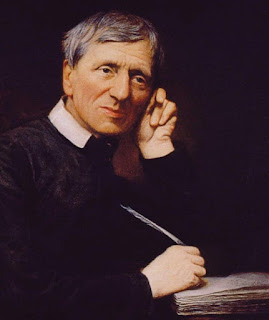I am going to apply this remark to the subject of the prerogatives with which the Church invests the Blessed Mother of God. They are startling and difficult to those whose imagination is not accustomed to them, and whose reason has not reflected on them; but the more carefully and religiously they are dwelt on, the more, I am sure, will they be found essential to the Catholic faith, and integral to the worship of Christ. This simply is the point which I shall insist on—disputable indeed by aliens from the Church, but most clear to her children—that the glories of Mary are for the sake of Jesus; and that we praise and bless her as the first of creatures, that we may confess Him as our sole Creator.
When the Eternal Word decreed to come on earth, He did not purpose, He did not work, by halves; but He came to be a man like any of us, to take a human soul and body, and to make them His own. He did not come in a mere apparent or accidental form, as Angels appear to men; nor did He merely over-shadow {345} an existing man, as He overshadows His saints, and call Him by the name of God; but He "was made flesh". He attached to Himself a manhood, and became as really and truly man as He was God, so that henceforth He was both God and man, or, in other words, He was One Person in two natures, divine and human. This is a mystery so marvellous, so difficult, that faith alone firmly receives it; the natural man may receive it for a while, may think he receives it, but never really receives it; begins, as soon as he has professed it, secretly to rebel against it, evades it, or revolts from it. This he has done from the first; even in the lifetime of the beloved disciple [St. John] men arose who said that our Lord had no body at all, or a body framed in the heavens, or that He did not suffer, but another suffered in His stead, or that He was but for a time possessed of the human form which was born and which suffered, coming into it at its baptism, and leaving it before its crucifixion, or, again, that He was a mere man. That "in the beginning was the Word, and the Word was with God, and the Word was God, and the Word was made flesh and dwelt among us," was too hard a thing for the unregenerate reason.
These two longer sermons/discourses are most appropriate spiritual reading for the month of August.
In 1864 he answered his old Oxford Movement friend, E.B. Pusey, to defend the recent proclamation of the doctrine of Mary's Immaculate Conception with a public letter, but that's beyond the limits of these brief segments to get into!
In his Meditations and Devotions, he included a series of meditations on the Litany of Loretto for the month of May. He divided these meditations into four parts after two introductions to the month of May: The Immaculate Conception, The Annunciation, Our Lady's Dolours (Sorrows), and The Assumption.
Newman also wrote a Litany to the Immaculate Heart of Mary to be used from August 1 to 15 (the Feast of the Assumption of Our Lady) for private devotion:
Heart of Mary, Pray for us.Heart, after God’s own Heart, Pray for us.
Heart, in union with the Heart of Jesus,
Heart, the vessel of the Holy Ghost,
Heart of Mary, shrine of the Trinity,
Heart of Mary, home of the Word,
Heart of Mary, immaculate in thy creation,
Heart of Mary, flooded with grace, {242}
Heart of Mary, blessed of all hearts,
Heart of Mary, Throne of glory,
Heart of Mary, Abyss of humbleness,
Heart of Mary, Victim of love,
Heart of Mary, nailed to the Cross,
Heart of Mary, comfort of the sad,
Heart of Mary, refuge of the sinner,
Heart of Mary, hope of the dying,
Heart of Mary, seat of mercy,
************************
O most merciful God, who for the salvation of sinners and the refuge of the wretched, hast made the Immaculate Heart of Mary most like in tenderness {243} and pity to the Heart of Jesus, grant that we, who now commemorate her most sweet and loving heart, may by her merits and intercession, ever live in the fellowship of the Hearts of both Mother and Son, through the same Christ our Lord.—Amen.







.jpg)

